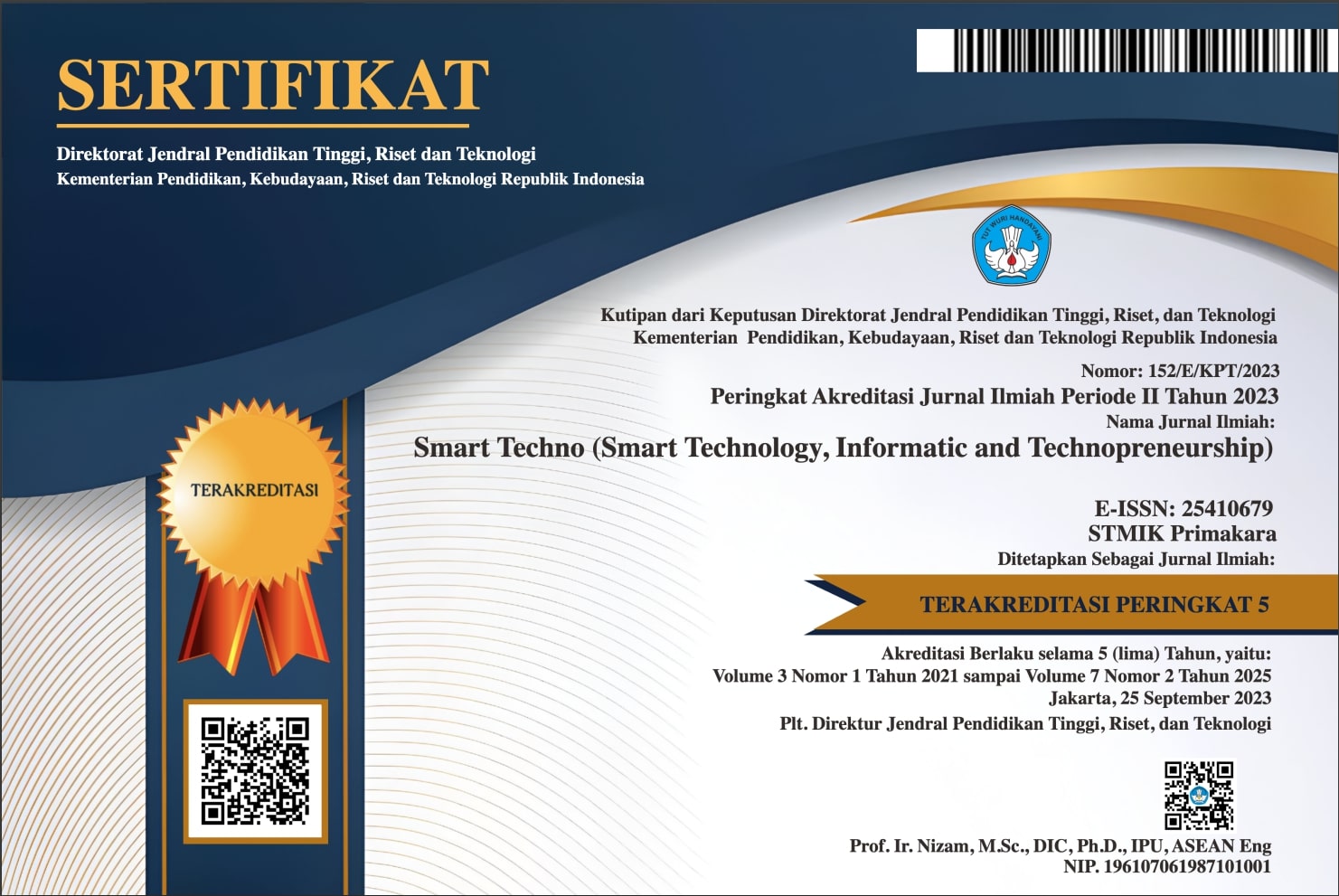Knowledge Sharing Dalam Kolaborasi Kampus Mengajar Untuk Meningkatkan Literasi Dan Numerasi : Kajian Literatur
Indonesia
Abstract
Penelitian ini bertujuan untuk menganalisis bibliometrik terhadap knowledge sharing dalam kolaborasi Kampus Mengajar dalam meningkatkan literasi dan numerasi. Data yang diperoleh terkait dengan kata kunci “knowledge sharing" OR " Kampus Mengajar" OR "literasi dan numerasi” dengan batas waktu dari tahun 2021 sampai dengan tahun 2024 dengan total 778 dokumen dari database Google Scholar. Data diolah menggunakan perangkat lunak yaitu Publish or Perish dan VOSViewer untuk visualisasi data. Hasil penelitian menunjukkan bahwa topik literasi dan numerasi, serta program Kampus Mengajar, menjadi fokus utama dalam periode tersebut. Analisis klaster mengungkapkan hubungan erat antara topik-topik ini dan menyoroti peluang penelitian lebih lanjut untuk meningkatkan literasi dan numerasi melalui program kerja yang terintegrasi dengan teknologi digital.
Downloads
References
[2] E. Romaito Panggabean, A. Silvianita, T. University, J. Telekomunikasi, dan J. Barat Indonesia, “PENGARUH KNOWLEDGE SHARING TERHADAP KOMPETENSI MELALUI BUDAYA ORGANISASI SEBAGAI MEDIATOR PROGRAM STUDI MANAJEMEN FAKULTAS EKONOMI DAN BISNIS UNIVERSITAS KOMPUTER INDONESIA BANDUNG,” JURISMA: Jurnal Riset Bisnis dan Manajemen, vol. 11, no. 2, 2021.
[3] B. A. R. Rachman, Firyalita Sarah Fidaus, Nurul Lailatul Mufidah, Halimatus Sadiyah, dan Ifit Novita Sari, “Peningkatan Kemampuan Literasi dan Numerasi Peserta Didik Melalui Program Kampus Mengajar Angkatan 2,” Dinamisia : Jurnal Pengabdian Kepada Masyarakat, vol. 5, no. 6, hlm. 1535–1541, Des 2021, doi: 10.31849/dinamisia.v5i6.8589.
[4] C. Sitepu dan C. Nainggolan, “Meningkatkan Kemampuan Literasi dan Numerasi di SMP Asuhan Raya melalui Pembiasaan Praktik Baik dalam Program Kampus Mengajar Angkatan 4,” hlm. 449–454, 20223.
[5] PISA 2022 Results (Volume I). dalam PISA. OECD, 2023. doi: 10.1787/53f23881-en.
[6] W. D. Warsitasari, “Tren Penelitian Literasi Matematika di Indonesia: Analisis Bibliometric,” JIPM (Jurnal Ilmiah Pendidikan Matematika), vol. 12, no. 2, hlm. 255, Mar 2024, doi: 10.25273/jipm.v12i2.18144.
[7] F. Sawan, M. P. Dr. Nurhattati, dan M. P. Prof. Dr. Dra. Neti Karnati, Knowledge sharing: strategi penguatan perilaku berbagi pengetahuan guru dalam perspektif servant leadership. Nas Media Pustaka, 2021. [Daring]. Tersedia pada: https://books.google.co.id/books?id=caA4EAAAQBAJ.
[8] M. Noor, F. Suaedi, dan A. Mardiyanta, COLLABORATIVE GOVERNANCE Suatu Tinjauan Teoritis dan Praktik. 2022.
[9] S. Azizah, “The 21 st Century Skills through Literacy and Numeracy at Public Junior High Schools in Pamekasan Madura,” Proceedings of the 6th International Conference on Islamic Studies (ICONIS), hlm. 13–18, 2022.
[10] M. Katharina Bha, F. Dopo, F. Bate Dopo, M. Wewe, dan S. Tinggi Keguruan Dan Ilmu Pendidikan Citra Bakti, “Pendampingan Kegiatan Literasi dan Numerasi dalam Program Kampus Mengajar,” JIIP (Jurnal Ilmiah Ilmu Pendidikan) , vol. 7, no. 6, hlm. 5205–5209, 2024, [Daring]. Tersedia pada: http://Jiip.stkipyapisdompu.ac.id.
[11] P. Herawati, S. B. Utami, N. Karlina, ) Program, dan S. Pascasarjana, “ANALISIS BIBLIOMETRIK: PERKEMBANGAN PENELITIAN DAN PUBLIKASI MENGENAI KOORDINASI PROGRAM MENGGUNAKAN VOSVIEWER,” Jurnal Pustaka Budaya, vol. 9, no. 1, hlm. 2442–7799, 2022, [Daring]. Tersedia pada: www.scopus.com.
[12] A. Nurrosidah dan I. Artikel Histori Artikel, “Work Engagement: A Systematic Literature Review and Bibliometric Analysis hh ETNIK : Jurnal Ekonomi-Teknik Work Engagement : A Systematic Literature Review and Bibliometric Analysis,” ETNIK: Jurnal Ekonomi - Teknik, vol. 1, no. 11, hlm. 757–767, 2022.
[13] N. Donthu, S. Kumar, D. Mukherjee, N. Pandey, dan W. M. Lim, “How to conduct a bibliometric analysis: An overview and guidelines,” J Bus Res, vol. 133, hlm. 285–296, Sep 2021, doi: 10.1016/j.jbusres.2021.04.070.
[14] A. Karim, “Analisis Bibliometrik Menggunakan Vosviewer Terhadap Trend Riset Matematika Terapan Di Google Scholar,” Jurnal Riset Pendidikan Matematika Jakarta, vol. 3, no. 2, hlm. 23–33, Feb 2022, doi: 10.21009/jrpmj.v3i2.22264.
[15] D. Ramdani dan S. Rodiah, “Kajian Literatur Review: Riset Akuntansi Keperilakuan,” Inisiatif: Jurnal Ekonomi, Akuntansi dan Manajemen, vol. 3, no. 1, hlm. 373–390, 2024, doi: 10.30640/inisiatif.v3i1.2175.
[16] R. Chaudhuri, A. Apoorva, D. Vrontis, E. Siachou, dan E. Trichina, “How customer incivility affects service-sector employees: A systematic literature review and a bibliometric analysis,” J Bus Res, vol. 164, 2023.
[17] Y. J. Pambudi, D. T. Priyadi, A. Rahmawati, dan D. S. Ratana, “Cross Border E-Commerce: Tinjauan Pustaka Sistematis,” Jurnal Administrasi Bisnis, vol. 13, no. 1, hlm. 31–44, Mar 2024, doi: 10.14710/jab.v13i1.56984.
[18] “Management of hydrogen mobility challenges: A systematic literature review,” J Clean Prod, vol. 410, 2023.
[19] M. D. Rizqi, W. A. Saputra, dan M. Murahman, “Menggali Hubungan antara Media Sosial dan Kebijakan Pemerintah: Pendekatan Bibliometrik dan Tinjauan Pustaka,” Jurnal Kawistara, vol. 13, no. 3, hlm. 389, Des 2023, doi: 10.22146/kawistara.78591.
[20] M. Mahmudin, T. Herman, E. Supriyadi, R. S. F. Iskandar, dan R. Sugiarni, “ANALISIS BIBLIOMETRIK LITERASI MATEMATIKA DALAM DATABASE SCOPUS MENGGUNAKAN VOSVIEWER,” AKSIOMA: Jurnal Program Studi Pendidikan Matematika,
Copyright (c) 2024 Ahmad Fadhil Nugroho

This work is licensed under a Creative Commons Attribution 4.0 International License.
Authors who publish with the Smart Techno agree to the following terms:
- Authors retain copyright and grant the journal the right of first publication with the work simultaneously licensed under a Creative Commons Attribution License (CC BY-SA 4.0) that allows others to share the work with an acknowledgment of the work's authorship and initial publication in this journal.
- Authors are able to enter into separate, additional contractual arrangements for the non-exclusive distribution of the journal's published version of the work (e.g., post it to an institutional repository or publish it in a book), with an acknowledgment of its initial publication in this journal.
- Authors are permitted and encouraged to post their work online (e.g., in institutional repositories or on their website) prior to and during the submission process, as it can lead to productive exchanges, as well as earlier and greater citation of published work. (See The Effect of Open Access)







